Below you can find PDFs and video recordings of the slides we cover in the intro to low-tech process-based restoration virtual workshop. Each is licensed with a Creative Commons licence, so you are free to re-use subject to the terms of the license.
Module 2: Underlying Science & Case Studies for Low-Tech PBR Process-Based Restoration
Module 2 Video Playlist
Watch entire Module 2 YouTube Playlist, or scroll below for individual topics, resources and videos.
Slides & Videos by Topic
These talks are elaborated in Chapter 1 and Chapter 2 of the design manual.
See also these additional Module 2 - Science & Case Studies Resources.
A. Logistics, Learning Objectives & Introductions
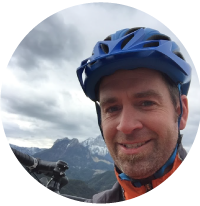 Joe Wheaton introduces Module 2 of the Low-Tech Process-Based Restoration Workshop: Underlying Science & Case Studies for Low-Tech Restoration.
Joe Wheaton introduces Module 2 of the Low-Tech Process-Based Restoration Workshop: Underlying Science & Case Studies for Low-Tech Restoration.
Video
B. Mimicking & Promoting Wood Accumulation & Beaver Dam Activity
 Joe Wheaton goes over the key processes to design & solve for with low-tech restoration for the Low-Tech Process-Based Restoration Workshop.
Joe Wheaton goes over the key processes to design & solve for with low-tech restoration for the Low-Tech Process-Based Restoration Workshop.
Background : This talk is based on Chapter 1 & Chapter 4 of design manual.
Video
C. Beaver Dam Analogues: Bridge Creek & Birch Creek
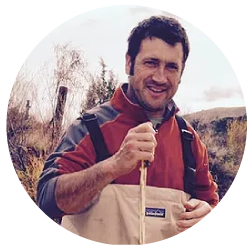 Nick Bouwes discusses testing the effecvtiveness of process-based restoration using to promote wood accumulation and beaver dam activity in some case studies of intensively monitored watersheds (IMWs) including Bridge Creek, Birch Creek and the Asotin IMW.
Nick Bouwes discusses testing the effecvtiveness of process-based restoration using to promote wood accumulation and beaver dam activity in some case studies of intensively monitored watersheds (IMWs) including Bridge Creek, Birch Creek and the Asotin IMW.
Background : This talk has 3 parts and is based on Chapter 1 & Chapter 4 of design manual.
Intensively Monitored Watersheds
Video Part 1
Bridge Creek - BDA Case Study
Video Part 2
Resources:
-
Bridge Creek Resources
- ISEMP Bridge Creek Website
- Silverman NL, Allred BW, Donnelly JP, Chapman TB, Maestas JD, Wheaton J, White J and Naugle DE. 2018. Low-tech riparian and wet meadow restoration increases vegetation productivity and resilience across semi-arid rangelands. Restoration Ecology. DOI: 10.1111/rec.12869.
- Weber N, Bouwes N, Pollock M, Volk C, Wheaton JM, Wathen G, and Jordan C. 2017. Alteration of stream temperature by natural and artificial beaver dams. PLOS ONE. 12(5): e0176313. DOI: [10.1371/journal.pone.0176313]
- Bouwes N, Weber N, Jordan CE, Saunders WC, Tattam IA, Volk C, Wheaton JM and Pollock MM. 2016. Ecosystem experiment reveals benefits of natural and simulated beaver dams to a threatened population of steelhead (Oncorhynchus mykiss). Scientific Reports. 6: 28581. DOI: 10.1038/srep28581]).
- Bouwes N, Bennett S and Wheaton JM. 2016. Adapting Adaptive Management for Testing the Effectiveness of Stream Restoration: An Intensively Monitored Watershed Example. Fisheries. 41: 2: pp. 84-91. DOI: 10.1080/03632415.2015.1127806
- Pollock, M., Beechie T , Wheaton JM, Jordan C, Bouwes N, Weber N, and Volk C. 2014. Using Beaver Dams to Restore Incised Stream Ecosystems Bioscience. DOI: 10.1093/biosci/biu036.
- Pollock M, Wheaton JM, Bouwes N and Jordan CE. 2012. Working with Beaver to Restore Salmon Habitat in the Bridge Creek Intensively Monitored Watershed: Design Rationale and Hypotheses. NOAA Technical Memorandum, NOAA Northwest Fisheries Science Center, Seattle, WA, 108 pp.
Birch Creek - BDA Case Study
Video Part 3
Resources:
Birch Creek Restoration Overview
Hear the Birch Creek Beaver story directly from Jay. This video is from his presentation during the 2019 Low-Tech Workshop.
Jay’s Birch Creek Story- Slides
Panel Discussion
Questions to the Panel
-
Panel Q & A for Module 2 Panel Discussion 1: Bridge Creek & Birch Creek
- Question: What is the watershed size of bridge creek/ d you find a limit to how large a watershed this is effective without blowing out (obviously relates to hydrology etc)...but any rules of thumb?
Answer: (Joe Wheaton) It is less a question of watershed size, and more a question of stream power. This is what we do in the BRAT (Beaver Restoration Assessment Tool).
- Question: Can you provide references for Beaver relocation facilities/people. Sherri Tippe was our CO lead for this but is now more retired.
Answer: (Mark) In CO we have no organized/centralized beaver relocation program. Some individual trappers do it on a case-by-case basis. In my experience, it is usually prohibitively difficult to permit this activity. (Joe) It is different in every state. We update LTPBR contractors & groups that can help with beaver relocation on the LTPBR Contractor's Page.
- Question: These projects are large wide open sites with minimal infrastructure. Are BDA's appropriate in urban areas with no beavers? Beavers would never build upon structures so function of BDA's would be short lived without continued maintenance...should we still install them?
Answer: (Nick Bouwes) BDAs are great way to test some of the effects of beaver without the commitment of adding beaver. But they are likely to need maintenance until their goals are met (e.g. floodplain reconnection, channel aggradation).
- Question: Once the aggredation hits or approaches the top of the BDA, can you build additional BDAs at the new level?
Answer: (Steve Bennett) Yes, you can and we have built on existing BDAs when they fill with sediment.
- Question: When you look at inundation before/after from aerial images are you using software to map those areas or hand drawing the polygons?
Answer: (Nick Bouwes) We drew polygons by hand.
- Question: In the Bridge Creek Case study, what was the stream slope pre treatment?
Answer: (Nick Bouwes) Bridge was 1-3% gradient.
- Question: What is a passive instream attenae?
Answer: (Steve Bennett) We use Passive Integrated Transponder tags (PIT tags) to tag fish - it has a 13 digit unique code. When a tagged fish swims over an antenna a data logger on shore records the code so we can tell if a fish enters or leaves the stream or reach. You can log on to PTAGIS.org and see all 50 million PIT tags used in the Columbia River basin since the late 1980s. (See also Fish Passage Resources)
- Question: What is the difference between upper owens and lower owens and difference in fish density?
Answer: (Nick Bouwes) The upper owens was a control reach, lower owens was the paired treatment reach. We have far more beaver dams in lower, but upper owens also had a large beaver response as beaver spread out from our treatment reaches. But upper owens dams blew out much more frequently than lower owens because of the lack of BDAs. Densities were higher in lower owens that upper owens- on average increase of 50 fish/100m.
- Question: Did the folks in the town of Mitchell blame the flooding on the beavers and your project? What kind of outreach did you conduct before the project began?
Answer: (Nick Bouwes) From what I have heard, no. This was not the first time they have seen flooding events like this.
- Question: Nick, what was the total budget for this project? We badly need such an IMW in California.
Answer: (Nick Bouwes) We likely spent about 300-400K per year. But that is not to say this is how much an IMW costs. We measure a lot of responses with the idea if we cannot detect a response with this much investment we are not going to ever see a response. I believe there are several indicators that would be much cheaper to measure especially with remote sensing and drone imagery available these days.
- Question: fish numbers went up post project...but didn't you seed the site with 100k tagged fish??? of course the numbers will go up!!!
Answer: (Nick Bouwes) Not sure I understand the question: we captured and tagged fish that were there, we did not add any fish. We did this pre-restoration and post-restoration in both our treatment and control watersheds.
- Question: Do they provide data on tagged fish and temperature?
Answer: (Nick Bouwes) I do not know what “they” refers to. Seeing your earlier question, maybe you mean the tags. The tags are not archival tags. They only provide an ID when stimulated by an antenna, which tells you when they are resighted. The proportion of resighted and recaptured to undetected with the right analytical approaches provides information on abundance, survival and growth.
- Question: So maybe stand alone structures that are larger could be passage barriers but when the number of structures are greater allowing them to work together the passage increases?!
Answer: (Nick Bouwes) I think it is very difficult to build a structure by hand that will be a passage barrier. That said, it is possible that when multiple structures step down the gradient of larger structures this could increase passage (if it is a problem).
- Question: What preys on beavers?
Answer: (Nick Bouwes) Cougars, bear, coyotes, wolves, and people.
- Question: So, does this data show that beaver activity might mitigate a flooding and drought liability, and convert the rainfall into a groundwater asset all at agricultural profit? FEMA spends millions in Mitigation dollars, and they are currently looking to fund Nature-Based Projects that can document a high ROI (return on Investment); which is one of their moonshot goals.
Answer: (Nick Bouwes) Yes, we believe this data does provide evidence of resiliency to drought and flooding (Jeremy will show more on this). As Joe showed yesterday, beaver complexes also provide resistance and resilience to fire.
- Question: For birch creek, did you reintroduce beavers after you built bdas or did they come on their own? (11 were introduced pre-bdas but did not stay)
Answer: (Nick Bouwes) after we built bdas we introduced 5 in 2015, and 6 in 2016. They built 140 dams in 3 years.
- Question: And these Nature-Based projects might benefit fish populations that will get support of environmentalists and fishing industry alike?
Answer: (Nick Bouwes) That is our hope.
- Question: I missed which Birch creek in Idaho that you were working on? what region is that in?
Answer: (Nick Bouwes) This is a tributary to Mink Creek, which is a trib to the Bear River, in SE ID.
- Question: When sizing the material for a structure do you look at maximum flows in the area? Rely on available materials?
Answer: (Nick Bouwes) We mostly rely on what is there for BDAs. We might have to bring in wood for PALs. In low power systems you can get away without post, but in higher energy systems post can add a lot structural integrity.
- Question: What's the best way to measure pre/post monitoring on groundwater changes? Wells with PZs? Dug by hand or with a drill bit?
Answer: (Nick Bouwes) Yes, we drilled wells with well drilling tool (large drill bit on a large tripod). We installed multiple wells with PZs in transects perpendicular to the stream.
- Question: What methods did you use to measure the water table depth?
Answer: (Nick Bouwes) we drilled wells with well drilling tool (large drill bit on a large tripod). We installed multiple wells with piezometers (loggers), in transects perpendicular to the stream.
- Question: Is there a rule of thumb on when to use BDAs and when to use large woody debris?
Answer: (Nick Bouwes) We will get into this more in upcoming talks, and some of this was covered yesterday. In short, there is no rule of thumb, but trade-offs between effort (PALs are much faster to build), and the ability to immediately pond water (BDAs). So depends on your goals and time-frame.
- Question: I've heard a lot of conflicting evidence about how beaver dams affect water temperature. I'm curious if you know whether the beaver ponds created in Bridge Creek were already forested/shaded or if many of them were exposed to a lot of light. Did you notice how those conditions affected ponded water temperature?
Answer: (Nick Bouwes The responses are equivocal and will depend on the system. There was not a ton of shade in Bridge Creek, but as willow have been increasing, shade has increased. No doubt that the more shade the less energy and less that the stream will warm up. But the hyporheic exchange is factor that is often not taken into account in how beaver ponds can cool streams.
- Question: A beaver biology question - maybe better for yesterday but, Can someone talk about how beaver expand range? How far will they go? How big are barriers such as roads? How about using estuaries, bays and coast lines to enter new watersheds?
Answer: (Nick Bouwes) They can travel great distances. Some work by the Methow Beaver Project have documented PIT tag beaver detected at PIT antenna 300 miles away. Beaver moving 10-20 miles is probably pretty common. I have seen a lot of road kill beaver. But if the habitat is good they might not move at all. Beaver use estuaries quite a bit. I am not sure how much these environments lead to dispersal but would not surprise me all that they use them extensively.
- Question: What is the latest research on the relationship between beaver, beaver restoration and whirling disease?
Answer: (Nick Bouwes) no evidence that they transmit whirling disease but something we are studying at the moment. But fine sediments is where you find the tubifex worm which is the carrier so it likely contributes to establishment of whirling disease. On the flip to this, in good habitat and healthy fish, fish can show little symptoms and survive the disease just fine.
- Question: Amazing work. Have you dealt with multiple landowner situations like this?
Answer: (Nick Bouwes) We have dealt with some landowners and have request from ranchers to get beaver established on their property. Generally they are quite supportive. Beaver are an easier sell than a lot people think.
- Question: Would you say that the monitoring of schemes nationally is much better present-day or is this still a challenge?
Answer: (Nick Bouwes) I do think it is better present day, but I still think it is a challenge. And the funding is often not for monitoring responses that we are really interested in (i.e. funding to evaluate the stability of structure, rather than the results of the structures).
- Question: For Birch Creek, you mentioned that you introduced several beavers following BDA construction, and then the creek went dry that first year. Did the introduced beavers persist through the time the creek was dry, or did you have to relocated another batch of beavers the following year? Also, were you relocating beavers during the spring when flows were higher?
Answer: (Nick Bouwes) I should have clarified, so thanks for asking. Higher in the watershed where the beaver were building ponds the flows are perennial. It dries up lower in the system. We relocated beaver in the late summer and fall. The idea is that they starting dam building closer to winter when they start to cache food in ponds. But I think you can relocate anytime outside winter if they have deepwater habitat
- Question: Was there a comparison of benthic habitat with/without treatment and implications/quantification for fishes/inverts? Or will we get to that later?
Answer: (Nick Bouwes) The benthic invertebrate community was different between ponded and free flowing reaches. But we did not quantify differences in secondary production. Substrate in free flowing reaches dominated by cobble. In beaver ponds was mostly fines and gravel areas near the head of the pond, or when dams blow out.
- Question: I imagine there will be water rights discussion at some point this week. Somehwhat related to that, I am curious about impacts to downstream water rights users and on the ground impacts. if mgmt occurs upstream, is it expected that an longer seasonal flows will occur downstream in areas that are mostly unmanaged?
Answer: (Nick Bouwes) we will get into this more. But yes, we have to deal with concerns of water users downstream of beaver/bda complexes. There is perception that if there is more water upstream then these complexes are “stealing” water from downstream users. But this water storage occurs during high flow events when irrigation is less important, and slowly releases and augments during the low flow periods.
- Question: Do beaver dams restrict movement of non-native trout introduced for sport fishing, e.g., brook, brown, and rainbows? Are there any studies documenting population impacts for non-native trout?
Answer: (Nick Bouwes) The paper by Lokteff et al. referenced in my talk looked at movement of native cutthroat, and non-native brook and brown trout. Brooks tend to stay put in ponds, cuts move back and forth, and browns tend to be lazier and not often do not negotiate dams.
- Question: If beavers are at such a low level, why don't natural resource agencies have a massive captive breeding program?
Answer: (Nick Bouwes) The demand for beavers often comes from aquatic folks. Wildlife managers often see beaver a nuisance animal that can be highly destructive and require management. There are also people who believe beaver are at carrying capacity already (even though beaver can alter their own carrying capacity) and we should not be moving them. But maybe in the future a breeding program might catch on.
- Question: What are the BDAs' limiting flow, height, and substrate?
Answer: (Stephen Bennett) Very large rivers are likely not suitable for BDAs (e.g., order 6 and up). However, beavers do build dams on the margins of large rivers where there are multiple channels or back-channels. We recommend that you do not build BDAs too high. For example if your stream is incised 2 m or 6 feet - build a BDA that is 1 m or 3 feet high. If the BDA traps sediment and the pond fills in build on top of the existing BDA - in other words, build BDAs in stages to reduce incision. You can build a BDA in any substrate type except maybe bedrock. Our best advice is to use local cues and especially observing what beaver populations in your area are doing - emulate their behavior. We also recommend using a pilot or trial project to sort out these type of questions - what’s the worst that can happen, your BDA may fail if you build it too high.
- Question: Since streams almost always adjust to their lowest bed elevation, is there any point to trying to rebuild an incised channel if you don’t have access/permission to work in the lower end of the stream downstream of the restoration reach? Similarly, can you restore a stream reach with these methods if you are working on just a portion of the stream (e.g., a single landowner along the stream wants restoration but others do not or cannot)? How do you deal with degraded areas up and downstream?
Answer: (Nick Bouwes) Good question and is a bit too complex for quick answer. If the gradient is stepped down, and you dissipate energy on the floodplain, AND you have structure, you do not have have to have a head cut from downstream control to your reach. But it is good idea to know what your conditions are upstream and downstream.
- Question: Have you had beavers abandon a reach because they decimated the tree sources? is that a concern for some land owners?
Answer: (Nick Bouwes) Yes beaver move out of areas if they deplete their food source. But often the abandon areas have regeneration and beaver may reoccupy (we like to call them rotational crop farmers). But, yes some trees do not regenerate and can be a problem for landowner. Caging or painting with paint with sand might be a form of mitigation
- Question: Often you have described the more BDAs in a stretch of stream the more effective these structures can be together. Is there a recommended BDA density per stretch of stream/linear feet/etc.?
Answer: (Nick Bouwes) Yes, multiple structures are important. The density of BDAs is dependent on gradient and how high you build your BDAs. It is easy to be redundant if a BDA backs up water that inundated an upstream BDA. In general, do not go to high to quickly (more likely to blow out), and if you build going upstream you might be able to see where the ponding ends to place your next upstream BDA (but this is also dependent on flow)
- Question: Is anyone specifically studying beaver behavior changes in relation to BDA implementation for restoration? It sounds like there are changes in behavior with BDA's?
Answer: (Nick Bouwes) This is something that is starting to be looked at in the Methow Beaver Project. We also have some anecdotal evidence that they are more likely to stick around if there are BDAs are present because of the deep water habitat they provide.
- Question: It's very encouraging to see the monitoring results, especially when it comes to fish passage. (See also -Fish Passage Resources) I'm wondering how much of that success is due to geography and fish species, i.e. salmonids. Our agency is on the east coast, and we are concerned with the aquatic community as a whole. Our biggest trout of concern is brook trout. But we also have a number of other priority at risk fish species that are much smaller, like Chesapeake Log Perch. What are your thoughts regarding BDA's (especially the channel spanning type) being fish.
Answer: (Nick Bouwes) Brook trout use beaver ponds but this could be function of gradient and stream temperature. BDAs are much more leaky than beaver ponds and less likely to be a barrier. I can’t guarantee they will not be a barrier for log perch, but I suspect not, as there are often many routes of passage through a BDA.
- Question: Curious how much funding was received for bridge creek. Appears to be a long standing restoration project. In California, we often are limited by the funding to do continuous monitoring.
Answer: (Nick Bouwes) This was initially funded by Bonneville Power Administration that have to mitigate for the hydrosystem for listed salmon and steelhead. Money was spent to evaluate whether restoration can actually mitigate for the hydrosystem given the lack of evidence in the literature. We are now receiving funding from Oregon Watershed Enhancement Board (OWEB) to continue the monitoring given the uptake in this approach and what are the long-term consequences.
- Question: Do blow-outs of BDAs cause headcuts and how do you prevent it from happening.
Answer: (Nick Bouwes) I can cause head cutting in the sediment you captured. But I don’t believe they will cause more harm than the initial condition. But this is all the reason for the strength in numbers principle, this can minimize the loss of any one structure.
- Question: I have heard about benefits to fish with floodplain accessibility. Does Nick have any insights to increases in size and numbers of fish with increased floodplain access that comes with higher frequency and duration of overbank events?
Answer: (Nick Bouwes) nundation of the floodplain at high water can provide velocity refugia that can be very important. Floodplain inundation year round can greatly increase habitat quantity and complexity for multiple life-stages. For example, fry are generally found in channel margins with very low flow, so beaver complexes greatly increase this habitat. We have observed much higher fish/100m in areas where floodplains have been inundated. We have also seen increased fish size in some systems in beaver ponded areas.
- Question: Has there been any problems with increased browsing by cervids at Birch creek.
Answer: (Nick Bouwes) We have seen an obvious increase in browsing.
- Question: What is the watershed size of bridge creek/ d you find a limit to how large a watershed this is effective without blowing out (obviously relates to hydrology etc)...but any rules of thumb?
D. Post-Assisted Log Structures Case Study: Asotin Creek
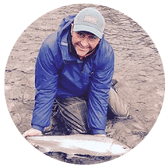 Steve Bennett presents a case study for low-tech process based restoration using Post-Assisted Log Structures on Asotin Creek.
Steve Bennett presents a case study for low-tech process based restoration using Post-Assisted Log Structures on Asotin Creek.
Background : This talk is based on Chapter 1 & Chapter 4 of design manual.
Video
E. Building Resilience with Low-Tech
 Jeremy Maestas goes over using low-tech process-based restoration methods to create riverscapes that are more resilient to drought, fire and flooding.
Jeremy Maestas goes over using low-tech process-based restoration methods to create riverscapes that are more resilient to drought, fire and flooding.
Background : This talk is based on Chapter 1 & Chapter 4 of design manual.
Video
Panel Discussion
-
Panel Q & A Module 2 Discussion 2: Asotin PALS & Resiliency
- Question: What did this all cost for the project from the first visit to now?
Answer: (Stephen Bennett) 4.6 million for 2008-2021 (14 years) of planning, designing, permits, fish and habitat monitoring, equipment, and restoration.
- Question: What factors determine which treatment to use on a watershed? Why were PALS used on Asotin and BDA's on Bridge Creek. What are the reasons to use one strategy over another in specific watersheds
Answer: (Stephen Bennett) We deliberately chose to test the effectiveness of PALS in Asotin because LWD restoration is extremely common throughout North AMerica. If we doing restoration for restoration sake we would have likely used a variety of PALS and BDAs. Keep in mind we also developed the PALS and hdLWD approach while we were conducting the experiment because we saw a need for more cost effective approaches to adding LWD to streams.
- Question: Most, if not all the photos are from watershed that don't seem to have any development/impervious surface. They also seem to have significant relief with limited vegetation. Have there been any projects in watersheds with lower relief and with development? Have any projects been done on the east coast?
Answer: (Stephen Bennett) Since PALS were developed they have been used in a wide variety of situations throughout the wester US. I know of some trials of PALS in the east as well. Check out this website to get an idea of projects we are aware of/involved in the West: https://bda-explorer.herokuapp.com . We have used PALS and BDAs in streams with gradients ranging from 1-4% in areas with little or no vegetation to areas that are heavily forested. Reading between the lines it sounds like you are trying to understand what these techniques may be appropriate. The easy answer is if your riverscape used to support woody vegetation in the valley bottoms and/or had beaver present - it is highly likely that there is less wood and/or beaver in those systems compared to historic. If you use the web link above you can see the variety of situations in over 100 km of treatments.
- Question: The project areas look very arid. What is the average annual precipitation in rainfall?
Answer: (Steve Bennett) ~20 cm at lower elevations (700-1500 feet) and > 120 cm at high elevations (4500-6000 feet)
- Question: What cause or causes were responsible for degrading the Asotin watershed to begin with?
Answer: (Steve Bennett) The usual suspects - logging, intensive dryland agriculture in uplands which greatly increased sediment inputs and high intensity storm runoff, grazing, roads, water withdrawal for orchards, straightening and armoring of banks. Note - many of these stressors were reduced or eliminated in the late 80’s and early 1990’s through implementation of a Model Watershed Plan that was co-developed by local landowners and agencies.
- Question: Beaver dams seem to bow downstream. It would be interesting to hear if anyone has bowed upstream. Same with bank attached. If not that alright, I'll orient all structures downstream.
Answer: (Steve Bennett) Good observations - we will be discussing construction on Friday - but if you look at page 41-42 in your pocket guide you will see that there is a hydraulic reason for BDAs and to a lesser extent channel spanning PALS being convex to flow (bowing down). When water flows over a convex structure it spreads out - dissipating energy across the structure - when water flows over a concave structure it converges in the middle increasing local energy and potentially leading to undercutting of dam.
- Question: How do you determine the density you want for PALs in the floodplain for design purposes?
Answer: (Steve Bennett) We did surveys of pre-restoration LWD densities and compared them with estimates from the literature and came up with rough estimates of PALS density. Another way we calculate density is by building a set of trial or pilot structures and observing how they influence flow - you then space your structures out so that their “zone of influence” does not overlap too much. This approach works fro BDAs too where you build from the downstream to upstream direction and build the next BDA at the edge of the pond created from the downstream BDA.
- Question: Does the sediment built up temporarily impede fish passage at spawn times during the restoration or was that a low-flow picture?
Answer: (Steve Bennett) No. There is a win win situation here. If you build a structures and it ponds very well (i.e., sediment fills structure). Then water will naturally flow over and/or around the structure. If you’re unsuccessful at trapping sediment and ponding water - then you have a very leaky structure and fish passage is provided through the structure. Perched culverts and concrete dams are barriers to fish … it is rare that a hand build wood structure can prevent fish passage. Native fish have evolved to co-exist with beavers and certainly LWD falling in streams.
- Question: So, the PALs cost ~$30-50k per mile. How much of that was materials, labor, transportation, etc? how does the cost compare to BDAs?
Answer: (Stephen Bennett) We had all the wood donated by the USFS - so the majority of the costs are from transporting the wood from the forest to the stream (in our case we were lucky and that distance is 20-40km) and the labor to build the structures (usually crews of 4-6 people with 2 trucks, trailers, atv’s and hydraulic post driver that was bought by the region and donated as match to the project). Costs for permitting and design were lower comparable to other LWD projects because ot the low-tech nature but still significant (5,000-7,500 per 4 km treatment). BDAs are more expensive on a per structure basis because they take longer to build - but materials are usually free and often available onsite. Permitting is slightly more expensive because the USACE also needs to review due to use of fill.
- Question: There was a historic flood of record in SE WA last February ... did it impact Asotin and if so have you seen the results?
Answer: (Stephen Bennett) Interestingly it does not appear so. Our peak flows were only 500 cfs in NF Asotin an SF and Charley were typical. However, we did have numerous medium sized peaks in the hydrograph which appear to have caused more failure than usual in the NF Asotin.
- Question: How do you determine when is it appropriate to use PALS vs. BDAS?
Answer: (Stephen Bennett) See Q2 above - the IMW is testing the effectiveness of PALS - so we did not want to muddy the waters with more than one treatment type (at least in the early stages)
- Question: Did the 2017 recruitment of wood onto the placed LWD threaten the road?
Answer: (Stephen Bennett) no. We are lucky where the infrastructure is limited in the study area and there is only one road crossing with an undersized culvert - but it is 4 km downstream of a treatment area and on the smallest stream where wood movement is limited by low flows and narrow channel (4-5 m wide).
- Question: How do you determine when is it appropriate to use PALS vs. BDAS?
Answer: (Stephen Bennett) This is a popular question and will be answered on Friday. The Bridge and Asotin IMWs were setup to test specific restoration approaches - in the case of Bridge Cr it was a relatively novel use of BDAs. In Asotin we wanted to test the effectiveness of LWD additions and added the twist that we wanted low-tech low impact way to add wood - so we developed PALS. In relatively we use both BDAs and PALS when implementing restoration projects. Generally speaking - if you goal is to relocate beaver or immediately connect to an inactive floodplain - use BDAs - they can pond water at low flow. If your stream is deeply incised and/or you very simple habitat - use PALS to widen the channel and start the aggradation process (bank blasters and mid channel structures followed by channel spanning structures downstream to capture sediment).
- Question: When you say "gone" on the post restoration slide, does that mean gone from the location they were placed, or gone from the project area completely?
Answer: (Stephen Bennett) Mostly I mean gone from where they were placed. We tagged all the wood we put in the streams, georeferenced it and then recorded tagged wood locations for 5-8 years after. Much of the wood that moved was caught on the first 1-10 structures downstream. A PhD student recently published these data. We do not know how much moved outside the project area because we could not survey the 40 km downstream due to private land concerns. I am sure 10-30% left completely - but we just don’t know. The average length of the wood was 2-3 m though - so it is a lot less likely to get caught and cause problems compared to whole trees.
- Question: How do you usually communicate the BDA's design to degrade naturally over time with the long term goal of creative the self-sustaining system to the average person?
Answer: (Stephen Bennett) It is sometimes a long conversation over several years to change the assumption that one restoration treatment will fix a river. We use structures to kick start processes - once natural wood recruitment increases, less PALS or BDAs need to be built. We don’t know how many treatments it will take to restore natural processes - but in most cases it may be decades of “maintenance” - this will require a complete re-thinking of what stream restoration means. We find that landowners are ok with this - you have to be honest with them.
- Question: How might these restoration techniques be best modified where there is not intact floodplain (urban areas with rigid constraints)?
Answer: (Stephen Bennett) It becomes about making smaller changes and being creative. There are more and more urban areas that are trying to make space for rivers - the next step will be to try making some of those urban streams more dynamic - this will require public outreach and education - but it is already happening. Many people that live in Asotin do not even know steelhead use the stream for spawning and rearing - we need locals to take ownership of these resources and have pride in maintaining healthy and productive riverscapes. Scaled-back structures, potential more engineered, can be implemented in urban areas to improve habitat. Engaging localsl in low-tech restoration also gives them a stake in the goals and objectives and are great education and employment opportunities for local kids.
- Question: Have there been any monitoring/studies on the impact of these structures on flood events/flood resiliency of downstream areas in these watersheds?
Answer: (Stephen Bennett) Not that I am aware off - but one of our goals is to build thousands of structures in a watershed to test this idea. It is all about scaling up.
- Question: Can BDAs/PALs help reduce flood damage in downstream communities where it isn't feasible to have these structures/ a "messy' riverscape? Thanks!
Answer: (Stephen Bennett) We don’t know - but it is theoretically possible - however, my guess is that for true riverscape restoration on a grand scale - some level of encouragement for people to move out of floodplains would be helpful to reduce flood risk more than any structures could do. The bottom line is that if infrastructure is in the valley bottom - there will always be a chance of a catastrophic flood damaging it. Not even engineers can prevent that.
- Question: Why no beaver in asotin creek?
Answer: (Stephen Bennett) There are beaver throughout Asotin but in very low numbers (few in each study creek). The state removed beaver dams the year we started the project and we have photographic evidence of large dams in the 1970s and 80s. However, the degraded nature of the streams, high predator levels (highest densities of cougars in state), and infrequent but large destructive flooding are likely preventing beaver from re-establishing in larger numbers. It is likely that trapping and shooting also are helping to limit re-establishment.
- Question: Are PALS, while less effective than BDA structures in certain regaurds, more suitable in certain habitats? If so what habitats are PALS more suitable in?
Answer: (Stephen Bennett) Both structures can be suitable - the question people need to ask is what are you trying to achieve and what is the most efficient and process-based way to get there. If you want a pond immediately - build a BDA - but be aware that unless you maintain it - it will likely start to leak - this is where the phrase “busy beaver” comes from - they maintain their dams constantly. If you want to widen a channel and begin incision recovery it is more efficient to build PALS if BDAs are going to fail due to high flows concentrated in the incised channel. We will talk more about design and construction on Thursday and Friday to address these types of questions.
- Question: Steve didn't mention beavers, but I think they're trying to introduce them in Asotin. Does he want to address that?
Answer: (Stephen Bennett) We are not relocating beaver in Asotin - we are relocating them over the hill in Tumalum Creek which is a tributary to the Tucannon. And I might add - we are not being too successful so far - predators are eating them before they can establish (0/10 so far).
- Question: Is it best to use PALS in situations where introducing beaver is impossible?
Answer: (Stephen Bennett) BDAs and PALS can be used in places where relocation of beaver is difficult (let’s not say impossible - we went to the moon - we can relocate beaver to most places if attitudes and values change). See answers to similar questions - what are your goals - use the structures that best achieve those goals. It is a bit unfair because we have introduced these structures without diving into the design objectives - generally BDAs pond water at low flow and PALS do geomorphic work and high flows - much more on this to come in next two days
- Question: I believe this was covered yesterday, but which NRCS practice would cover BDAs or PALS. Have these been funded previously under EQIP or is there a different NRCS funding program or non-NRCS funding program that supports installation of these types of restoration structures?
Answer: (Stephen Bennett) NRCS 643. Yes, NRCS has funded BDAs and PALS under EQIP.
- Question: What would you say to the PFC process that does not put high value on woody debris in a desert upland environment?
Answer: (Stephen Bennett) I am not familiar with the BLM PFC assessment process - I did take a cruise through the published protocol and it looks a lot like other agency protocols - overly concerned with bank and channel stability but in general acknowledges the importance of beaver and wood in maintaining healthy riverscapes - so not sure what you are referring to specifically.
- Question: For Steve and Nick, in addition to seeing greater numbers of Juvenile fish post restoration, was there any observation of improved health of juvenile outmigrants, ie increased size.
Answer: (Stephen Bennett) For the Bridge Cr IMW - Nick observed a decrease in growth but increase in survival. In the Asotin, the story is much less clear. We did not see a significant decrease in growth and survival increases were varied - it seemed like the fall survival increased more than other season (we were expecting that maybe winter survival would be changed the most). We are still trying to disentangle many of the fish responses in Asotin and are attempting to calculate the smolts per female (something they did not do in Bridge) which can tells us if female steelhead produced more migrants (juvenile steelhead that survived and migrated from Asotin) in treatment areas compared to control areas which is a measure of freshwater productivity.
- Question: It’s fairly obvious how well these (PALs and BDAs) structures can work in less steep terrain. Do you have any case studies with steeper terrain with deeply incised and downgrading channels?
Answer: (Stephen Bennett) We have worked in streams ranging from ~ 1-5% and from < 1 m to > 6 m incision (3-30 feet). Lower gradient streams may produce less dramatic responses from PALS due to reduced stream power. Generally speaking - the higher gradient streams in many watersheds in the west tend to be higher up in the watershed which often had less impact from landuse compared to lower elevation areas - so they are not as high a priority for restoration. I see no reason why these techniques can’t be used wherever beaver or wood previously played a role in healthy riverscapes which is likely upwards of 20% grad.
- Question: Are there any case studies for BDAs on streams with strictly seasonal flow and if not do you have any predictions for the effectiveness of creating a water-sustaining area either year round or for a longer period after rainfall?
Answer: (Stephen Bennett) yes, we are working in a lot of intermittent streams, some of which we suspect were perennial pre-european disturbance. If you go back to Module 2 C - Bridge and Birch Creek talk - Birch Creek was intermittent - we then introduced beaver and built 20-30 BDAs to aid in their establishment. There were no beaver dams when we started the beaver relocation - there are now ~ 150 beaver dams and the water flowed year round for the first time in decades. We are hoping to replicate these results in other intermittent streams - we are also working in streams where the goal is to just keep water longer and increase vegetation productivity.
- Question: Steve, what do you attribute the smaller amount of floodplain recapture to in Asotin vs. Bridge Creek? Fewer channel spanning structures, lack of beaver involvement, PALS being more leaky?
Answer: (Stephen Bennett) Yes, all of the above. We are deliberately not building BDAs to test PALS as a LWD treatment (like many other projects). PALS do not pond water at low flow - so to get true floodplain connection we will need to aggrade the channel by capturing sediment and building bars to the point where water in the channel can spill on to the floodplain. One of the things that may be slowing this process is the resistant banks (alder roots and large substrate are difficult to erode) and moderate high flows since restoration was implemented. We may use BDAs in the future to test if a combination of PALS and BDAs is most effective in these situations.
- Question: What did this all cost for the project from the first visit to now?
F. Where Science is at: Ongoing & Outstanding Science
 Joe Wheaton talks about the science behind healthy riverscapes, structural starvation and wood accumulation, and beaver dam analogs vs. other similar structures.
Joe Wheaton talks about the science behind healthy riverscapes, structural starvation and wood accumulation, and beaver dam analogs vs. other similar structures.
Background : This talk is based on Chapter 1 & Chapter 2 of the design manual.
Video
G. Synthensis of Module 2: Underlying Science & Cases Studies of Low-Tech Restoration
 Joe Wheaton synthesizes Module 2 of the Low-Tech Process-Based Restoration Workshop; Underlying Science & Case Studies
Joe Wheaton synthesizes Module 2 of the Low-Tech Process-Based Restoration Workshop; Underlying Science & Case Studies

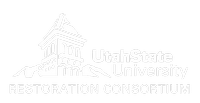

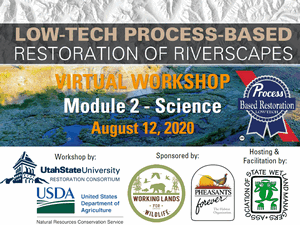

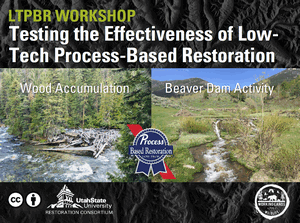
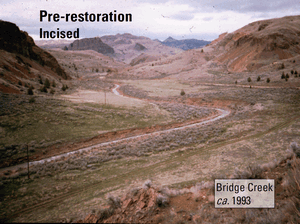
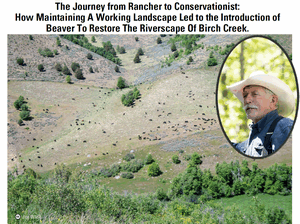
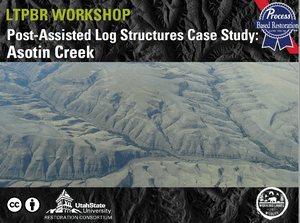
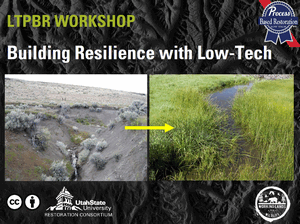

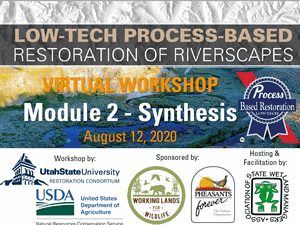
 Back to Virtual Workshop
Back to Virtual Workshop  Take this Module for University Credit or Professional CEU
Take this Module for University Credit or Professional CEU